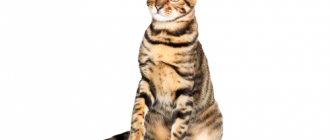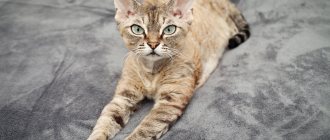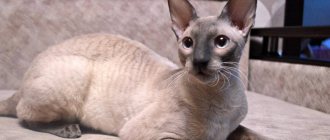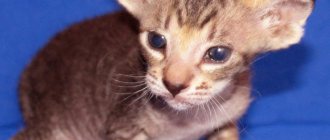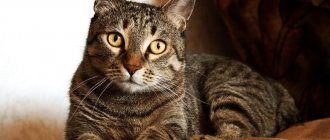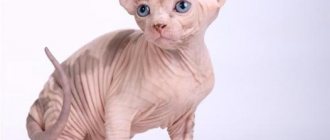Someone will say: “Ugh, what an alien!” - they will pass by and not look back, while others will be attracted by the unusual curly hair, like that of a young lamb, and... a surprisingly piercing gaze. And also the proud look and graceful gait of the queen. Yes, that's what they are - Cornish Rex cats.
No matter how they are treated, it is impossible to forget them. They are unusual and mysterious, although they owe their appearance to chance.
Description of the Cornish Rex breed
Popularity 79th place among 86 cat breeds
Lifespan:
14-16 years old
Height:
23-27 cm
Country of origin:
Great Britain
Average price:
20-35 thousand rubles
Weight:
3-5 kg
Latest articles Cat care
How to trim a cat's claws correctly and easily 01/28/2022 129 0 0
Dog health
How to do an ultrasound for dogs: preparation and procedure 01/28/2022 59 0 0
Key facts
The name of the breed comes from the county of Cornwall, located in the southwest of England, and the curly-haired rabbit of the rare Astrex breed. The country of origin of the Cornish Rex is recognized as Great Britain, where the first selection work to develop a new breed began.
Description of the Root Rex breed includes size standards. The weight of the Cornish is from 3 to 5 kg and depends on gender. Maximum sizes are typical for males. The average life expectancy of the Cornish Rex is from 14 to 16 years and is explained by a strong immune system and the absence of specific diseases transmitted at the genetic level.
The breed is distinguished by its curly coat, which is obtained by inheriting the recessive “rex” gene. The wavy curls covering the entire body of the animal resemble velvet. The aristocracy of graceful proportions is combined with developed body muscles; harmony is a key characteristic of the Cornish Rex in terms of appearance.
Cornish Rex are excellent jumpers, able to climb any elevated surface. These monkey habits often end in tragedy for vases or other fragile dishes, so experienced owners are advised to think through the entire storage system in advance.
Among the disadvantages of the breed, breeders note increased talkativeness. Undoubtedly, most cat lovers will count it as a plus, but sometimes the cat becomes too annoying. Keeping with other animals does not always help to redirect the pet’s increased attention, since the Cornish’s main interest is the owner.
If you are ready to devote most of your time to a cat, and the possibility of close contact with the animal is your main priority, then don’t even think about it. The curly-haired pet will quickly settle down on your lap and will gladly support any dialogue with funny and varied sounds.
Photos of colors
According to breed standards, the color of the Cornish Rex is allowed in all colors and patterns: solid colors, tabby, two-color, tortoiseshell.
Professionals know how to distinguish the breed and type of Cornish Rex from a photo.
History of the origin of the Cornish Rex
The country of origin of the breed is recognized as Great Britain, but the Germans claim that the first representative with curly fur was spotted on their territory. Shortly after the end of World War II, an unusual kitten settled next to a Berlin hospital. At that time, the residents were busy rebuilding the country and missed the chance to breed a new species.
The founder of the breed was the Englishwoman Nina Ennismore from Cornwall. In the 1950s, her beloved cat Serena gave birth to a ginger and white kitten with huge ears, curly hair, a lithe body and a wedge-shaped head. The baby with an extraterrestrial appearance stood out from the rest of the litter. All the other kittens had the classic appearance of English cats: strong bones, round heads and dense fur.
The further history of the breed was accompanied by many interesting facts that constantly threatened to put an end to curly-haired Cornish Rex cats. Miss Ennismore's charming ward, named Kalibunker, almost lost his ability to reproduce. The owner hurried to take him to be castrated, but was stopped by the veterinarian, who noted the animal’s amazing potential.
The little kitten was taken to Stirling-Webb and Jude, experienced breeders in the field of felinology. Scientists confirmed the uniqueness of Kalibunker and insisted on breeding him.
The first experiments were a fiasco. All kittens born from the mating of Kalibunker and his partner were born with straight hair. The results were crowned with success only when they decided to cross the curly cat with his mother. Three kittens from the litter inherited their father's appearance, which confirmed the recessiveness of the gene responsible for curly hair. Of the new curly-haired offspring, only one boy, named Poldu, survived.
Sudden financial difficulties befalling Miss Ennismore led to the forced euthanization of Serena and Kalibunker. The only survivor was a Cornish Rex cat named Poldu, bought by Stirling-Webb. Unfortunately, during the sampling of the material, the cat was accidentally castrated, but before that he managed to leave behind offspring. In 1967, the breed received official registration.
Ten years earlier, in 1957, the breeding of the American Cornish line began. A cat named Lamorna Cove was brought to the United States, bearing kittens from the victim Poldu. At first, Americans used Burmese, Siamese and American Shorthair cats to breed the breed. Such experiments resulted in deviations from the British standard, but allowed the development of many new colors.
After the breed was recognized by the largest felinological organizations in 1983, outbreeding, which involves breeding by crossing different breeds, was banned.
Owner reviews
The owners of Astrakhan cats say that there is no better pet than a therapy cat. The favorite thing of curly-haired healers is a massage, given with love to the owner and his family members. Sheep cats love to gently knead their owner's body with their paws, and bite and lick the hands of a person they trust. This is how the Cornish Rex expresses its love and devotion. Cornish cats are praised for their cleanliness - they are easy to litter train. Curly-haired cats are extremely smart and easy to train.
What does a Cornish Rex look like?
The general impression that emerges after meeting purebred animals is twofold. Fragility and sophistication are combined with strong bones, strong muscles and sharp claws.
The difference between American and English Cornish can be seen in the photo. Cats from the USA are more sophisticated than those from the UK. According to the approved standard, the maximum size of animals should not exceed 5 kg. This indicator is typical for cats. The weight of cats varies from 3 to 4 kg.
Breed defects include:
- massiveness and stockiness;
- sparse hair or the presence of bald patches;
- small ears;
- short tail without hair or with increased shaggyness;
- wide or long head.
Such animals are discarded from breeding. Sometimes even in a photo of a Cornish Rex you can notice a defect.
Muzzle
The head of the “Americans” resembles an egg, and the head of the “English” has the shape of a triangle. In both cases, the length of the head should exceed the width by 2 times. The wedge-shaped muzzle has clearly defined cheekbones. The Roman type of nose with a characteristic tubercle is located in line with the chin. The ears are set high and tapered at the tips. The color of the huge almond-shaped eyes depends on the color. The teeth are characterized by a scissor or level bite. A light snack is considered acceptable.
Body type
The head is located on an elegant and moderately long neck with well-developed muscles. The slender torso is slightly elongated and is accompanied by a toned stomach, moderately wide chest, defined waist and arched back.
The hind and forelimbs have thin bones but strong muscles. Strong pushes made by the hind limbs allow him to climb to the highest places in the house. Neat paws with long and well-developed toes are collected in oval pads.
The long and thin tail, tapering at the tip, is flexible and mobile.
Coat and color
You won’t be able to judge the softness of wool in pictures, so you need to get acquainted with soft plush only tactilely. The peculiarity of the breed is the complete absence of guard hair. The entire coat is a soft undercoat that lies tightly to the body. The minimum length of fur and the greatest number of curls are characteristic of the chest, lower part of the chin and belly.
A purebred kitten is visible from birth, but as it grows, it may lose its curls. It can be distinguished from a mestizo only after a year, when the curls return to their proper place. In addition to fur, Cornish cats have curly eyebrows and mustaches.
Acceptable colors of the Cornish Rex include:
- black;
- cream;
- ginger;
- white;
- blue;
- chocolate and many others.
Now they are stricter about color than 20-30 years ago. The American and English varieties of Cornish Rex have similar colors, and only a specialist can visually distinguish them.
Character of the Cornish Rex
Cornish is an inexhaustible source of energy, preferring racing for a ball to relaxing on a soft sofa. Cats use any discovered objects as toys, so it is better to hide valuables in an inaccessible place. Make sure you have enough interactive toys to direct your pet's activity in the right direction.
Before buying a Cornish at home, you will have to install an “anti-cat” - a special net that protects against falling from the window. Curly-haired cats love to explore the territory, so not a single flying pigeon escapes them. This sense of adventure can be dangerous without reliable window insurance.
The character of the Cornish Rex is very loyal, so the animals diligently surround their owners with their attention. Tactile signs of attention are always accompanied by sound signals that have a wide range. If you get a Cornish dog, you will soon learn to understand the meaning of the sounds it makes.
Cats treat strangers with caution, allowing close contact only after careful examination from the outside. Animals get along well with children, but do not tolerate excessive importunity. The child will not suffer from their paws, but the Cornish may receive psychological trauma from careless handling. When communicating with other animals, cats can show jealousy, and perceive rodents and birds only as prey.
Tailed pets love to sit on their hands, as they are constantly cold. Due to the small amount of fur, their body temperature appears to be higher than that of other cats, but this is a false impression. If you prefer to walk animals, then keep in mind that it is dangerous for Cornish cats to be outside in winter.
The breed is not suitable for workaholics, and even an ordinary five-day period causes an acute feeling of loneliness in cats. Cornish cats quickly become attached to their owners and are especially affectionate towards the female half of the family. The most affectionate characters are those cats that love to perch not only on the arms, but also on the shoulders of the owner.
Pros and cons of the breed
The positive aspects of living under the same roof with a Cornish Rex include their affection and friendliness. An active and cheerful curly cat will not let you get bored alone, and by cuddling and purring his tender song in his owner’s ear, he will lift his spirits and lift him out of despondency. A kind of curly antidepressant. The Astrakhan cat is clean, easy to train, and has the ability to perform simple tricks. Cornish cats are easy to litter train and have no odor.
The point about the disadvantages made me think for a long time - it seems that the cat-lamb has no disadvantages. The only minor drawback may be the occasional stubbornness shown by the Cornish people. But a cat’s self-will and presence of its own opinion are a manifestation of its intelligence.
Raising a Cornish Rex
The high intelligence of animals contributes to successful training from childhood. From the first days a kitten appears in the house, adhere to one rule: do not allow things to be done that are prohibited. If your pet is marking its territory, chewing foam, or scratching the sofa, gently plop a newspaper next to it. This can only be done immediately after the crime, so that the child understands the reason for the owner’s dissatisfaction. Please note that the animal must not be beaten. The owner's hands should be associated only with affection and used as praise.
Raising a Cornish Rex is similar to interacting with dogs. He easily remembers basic commands, quickly toilet trains and enjoys walking in a harness. Most quickly, animals get used to closed trays, which exclude direct contact with the owner or other animals. In such a toilet, the cat feels completely safe and does not try to relieve itself in the wrong place.
Well-mannered pets never take revenge on their owners and carefully observe the basic rules of hygiene in the house. To be on the safe side, place scratching posts in each room in the first stages. This will help you determine your favorite type of scratching post and teach the correct behavior.
A cat who loves to swim
And another unique feature of “alien” cats is that they love water treatments. Caring for an animal requires bathing at least twice a month.
Teach your kitten to this from childhood - he will like it, and he will be happy to expose his back and tummy for a massage. And then wrap it in a soft towel to prevent it from catching a cold. Drafts are dangerous for animals!
Don't forget about healthy eating. For Cornish Rex it is that 80% of the diet is meat, but not raw meat, as it increases the risk of infection with worms. Cats need vitamins and vegetables, and it is advisable to give them “fasting days” at least a couple of times a week.
The colors of the Cornish Rex can be different: at exhibitions and in nurseries there are white, black, red, bicolor or tricolor cats. All of them belong to the same breed of “curly cats”, which were born by accident, but have won the hearts of many lovers of mustachioed pets.
Cornish Rex Health
The Cornish Rex is in excellent health and has a long life expectancy. With proper care, some representatives live up to 16 years of age.
Possible diseases
If infectious diseases bypass the Cornish, then several pathologies are found in most purebred pets. These include:
- Retinal atrophy. The progressive depletion of photoreceptor cells responsible for vision leads to blindness.
- Hypokalemia. A lack of potassium in the body is fraught with pain in muscles and joints, respiratory failure and dynamic intestinal obstruction. Treatment depends on the severity of the disease, but most often the animal is prescribed vitamins with potassium for oral administration.
- Metabolic disorder. The most common consequence is obesity associated with the increased gluttony of the Cornish Rex.
- Hyperplasia of the gland in the tail area, or “greasy tail”. Excessive sebum production leads to an untidy appearance of the coat and provokes the activity of fungi and bacteria.
- Alopecia. It is very easy to distinguish alopecia from seasonal shedding. Completely bald patches appear on the paws, face, ears or other parts of the body.
For your pet’s health, follow the vaccination schedule and do not forget about anthelmintic treatment.
Reproductive health
Despite the fact that the first estrus occurs at 9 months, the birth of offspring should be postponed until 1-1.5 years. Early birth is fraught with miscarriages, fetal pathologies and even the death of the pet itself. Those who are far from breeding the breed are advised to take their pet for castration or sterilization. Operations are performed at 7-8 months.
Kittens from the same litter, growing together, mature faster, so lowering the age limit is acceptable for them.
Cornish Rex pregnancy lasts 62-66 days. Kittens are already covered with curls at birth, but lose them in the first week of life. After the juvenile molt, the usual appearance of the coat gradually returns.
Health and susceptibility to disease
With proper care and a high level of activity, Cornish Rex dogs can live up to 14-15 years. Despite strong immunity and good heredity, cats of this breed still have health problems.
Cornish Rex dogs have a predisposition to:
- to solar dermatosis;
- hypotrichosis;
- retinal atrophy;
- hypoglycemia.
Features of feeding and diet
Due to their increased activity, Cornish cats are constantly hungry. Be careful when feeding and follow your veterinarian's recommendations. An increased caloric intake is fraught with obesity and other complications.
For cats with metabolic disorders, veterinarians recommend periodic fasting. Please note that fasting days are carried out under the strict guidance of a doctor and do not always imply a complete refusal of food.
The animal's diet should be natural or dry. Mixing the two types is unacceptable and is fraught with disruption of the gastrointestinal tract. Dry food must be at least super premium. Pay attention to the country of origin. Good reviews are typical for Canadian production, while domestic producers still skimp on the quality of ingredients.
If you are in doubt about what food to feed your pet, consider the main indicators: age, health, general activity and size. Give preference to canned food with pieces of meat, as frequent consumption of dry food overloads the weak digestive system of the Cornish Rex.
Eating natural products requires strict adherence to daily caloric intake. Check with your veterinarian how many times to feed the Cornish to avoid obesity, deficiency or excess of vitamins. Until 1 year of age, focus on calcium, which is necessary for the proper formation of bone structure.
Contrary to popular belief, fish is dangerous for most cats and can cause urolithiasis. You should also avoid liver, which can change the color of the coat. Meat products should account for at least 80% of the diet.
Care and maintenance
Cornish Rex cats are easy to keep and suitable for people suffering from allergies to wool. Their fur is hypoallergenic, so only the animal’s saliva can cause an allergic reaction.
Shedding of animals is minimal and does not require major adjustments in daily care. Combing is carried out with a special mitten or suede cloth soaked in water. Using rougher tools can damage the hairs. The absence of guard hair interferes with the absorption of sweat, so the animal must be bathed every week. Washing is carried out with veterinary shampoos. After bathing, the pet must be wrapped in a towel and tried to dry, excluding exposure to drafts.
Clean ears weekly that accumulate environmental dust. To cleanse your eyes, use special solutions or chamomile infusion.
Due to the specific structure of their paws, Cornish cats do not know how to retract their claws and can scratch their owner during play. To grind down the claws, train your pet to use a scratching post or trim them yourself with a nail clipper.
Every month, clean your cat's mouth with veterinary paste, moving from the base to the tip of the tooth.
Caring for and maintaining a Cornish Rex is not difficult and will not puzzle even an inexperienced owner.
Tips for choosing a kitten
When choosing a kitten, do not save money by trying to choose an option with a lower cost. All prices are determined by the prestige of the nursery, the quality of the pedigree, the class of conformity to the exterior, the presence of vaccinations or operations performed. Savings can result in the purchase of a sick pet or mixed breed.
Before purchasing, seek a preliminary consultation to get to know the nursery's students and ensure the proper condition of the facility. All Cornish Rex kittens must be active and well-groomed. Do not buy animals with tousled fur, watery eyes and an unpleasant odor from the ears.
The responsible seller is required to draw up a sales contract and hand over breeding documents. Kittens under 2.5 months should not be offered for sale. Through mother's milk, they develop passive immunity, which helps protect against infections until the first vaccine is administered.
How to choose the right kitten
The Cornish Rex is no less common and popular breed than the Siamese, Scottish Fold or British. Therefore, there are usually no problems with finding a kitten, especially if you contact trusted breeders or certified nurseries.
When choosing a small Cornish, you should pay attention to the following nuances:
- availability of pedigree and veterinary passport;
- health status;
- conditions of detention;
- behavioral characteristics;
- compliance with the breed standard.
Important! If the kitten does not take part in games with littermates and looks unhealthy, it is better not to buy it.
Kitten care
Until the age of three months, a Cornish Rex kitten needs maternal care and cannot live independently. During this period, he receives his first vaccinations and learns basic things. Therefore, competent breeders begin to distribute curly-haired babies after they are 12 weeks old. This means that potential owners have enough time to prepare for the pet’s arrival.
To make the Cornish Rex kitten comfortable, they buy him:
- bed or house;
- tray and filler;
- carrying;
- toys;
- scratching post;
- a set of bowls for food and water;
- hygienic cosmetics (shampoos, lotions, etc.);
- grooming tools (toothbrushes, combs, nail clippers, etc.).
Important! For the sake of safety, decorative plants, electrical wires, household chemicals, medicines, small and fragile objects are removed from the little Cornish Rex.
To make it easier for the kitten to adapt to changed conditions, you can ask the breeder for any item with the smell of its native “nest”. And so that the little Cornish Rex gets used to the hands and his own nickname, he is often petted and called by name.
On a note. For a Cornish Rex kitten, it is better to choose an original short and easy to remember nickname. Suitable names for the cat include Abby, Kylie, Molly or Shayna. The cat can be called Shrek, Erwin, Noir or Wolf.
How much does a Cornish Rex cost?
Not all buyers understand that the price of Cornish Rex from the same litter can be different. The cost of animals is determined by their external characteristics and compliance with the established standard. Maximum prices are set for show-class Cornish dogs – ideal purebred representatives. For future winners of international exhibitions you will have to pay at least 40 thousand rubles.
For 25-40 thousand rubles you can purchase breed-class pets recommended for breeding. As a result of mating, these animals can produce offspring of a higher class.
For those who are not chasing high-profile titles and do not plan to participate in breeding, sellers advise taking a closer look at pet-class cats. These animals are sold for 10-25 thousand rubles and have minor defects that do not affect their health. If we talk about character, then such pets are no worse than their tailed counterparts and will easily conquer their future owners with their friendliness and restlessness.
Do you like the article? 0
Breeding
Those who want to start breeding this breed should find a partner in advance.
This may take several months, depending on where you live. In big cities this is easier and faster. This breed is still considered rare and has some peculiarities in its reproduction. Females become sexually mature at 9 months, but there is no need to rush. The animal’s body must become stronger and its hormonal levels must return to normal. The first mating is best done after a year. This applies to females and males. A categorically important condition for breeding a breed is a complete ban on the use of other cat breeds for these purposes. There is a risk of losing the gene that is responsible for the main characteristics of the breed - a special curly coat, ear shape and body type.
Mating and pregnancy of cats
Both animals must be in good health, have the necessary documents and vaccinations for the animal. The animal must be active, without signs of disease. In this case, the likelihood of getting healthy offspring increases significantly. The most important factors in choosing a partner are:
- pedigree of the animal;
- health;
- experience from previous matings.
Before mating, the animal must be treated for worms; it is recommended to trim its claws. The mating itself is carried out in the cat’s territory, and it is advisable for the cat to stay in this place for 3-5 days so that they get used to each other.
Unusual Cornish Rex with heterochromia.
Pregnancy lasts about two months – 63-65 days. If your health is good and there are no problems, childbirth is quick and easy. The approach of childbirth can be recognized by the behavior of the animal - the female begins to look for a quiet, secluded place for herself. The weight of kittens at birth is 100-110g. A cat brings up to 5 kittens per lamb. Newborn kittens have curly fur, but after a week it straightens. Curls begin to appear after the first molt.

